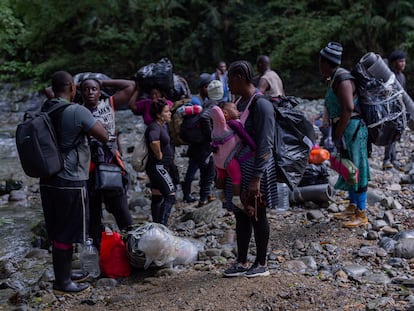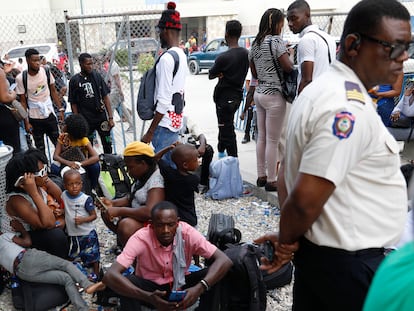The Church of La Soledad, a refuge for more than a thousand migrants in Mexico City
Given the saturation of the shelters, the parish church – one of the largest and oldest in the Mexican capital – has opened its doors to all those who are on their way to the United States
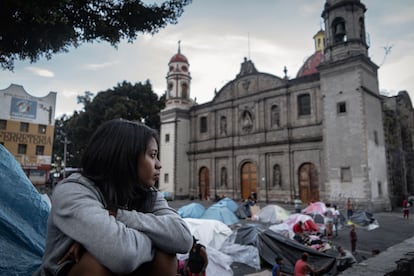
At night, the floor of the parish church is completely covered with thin mattresses. While the benches and the rest of the furniture are piled up against the walls, more than a thousand migrants use this space to rest, eat and receive medical attention and legal help.
In the Church of La Soledad (“our lady of solitude”) — one of the largest and oldest in Mexico City — weddings, first communions, or baptisms are no longer celebrated. Only Sunday Mass and a few others are celebrated during the week. Practically all the efforts of the parish priest and the three principal volunteers who support him are dedicated to helping those who — for a variety of reasons — have chosen to leave their countries of origin.
In recent years — given the growing presence of groups of migrants in the Mexican capital — this church, located in the central neighborhood of La Merced, in the Venustiano Carranza district, has become one of the main shelters for those on their way to the United States. Many stop in Mexico City along their journey.
Minutes before five in the afternoon, on October 27, around 50 people line up next to one of the side doors of the parish. The church is full, but this doesn’t matter: the 50 people are going to enter.
Benito Torres Cervantes is the parish priest of La Soledad. Originally from Mexico City and a priest for the past 18 years, he dedicates almost all of his time to caring for the hundreds of migrants who arrive, week after week, at his church in search of help. He either provides them with spiritual support, or offers them shelter and food. His motto is clear and he repeats it frequently to the volunteers and brigade members who provide their assistance to the church: “Until the last migrant.”
Father Benito arrived at this parish in 2015. Since then, he opened the doors of the church to help homeless people. Some of those who arrived were displaced foreigners who had no way of surviving in Mexico City. Generally speaking, though, there were never more than a couple of families who needed help. But everything changed with the arrival of the caravans from Central America and Venezuela. And, more recently, with the end of Title 42 in the United States, which allowed for immediate deportations during the pandemic. The priest estimates that there are currently around 1,300 migrants sheltering in the church.
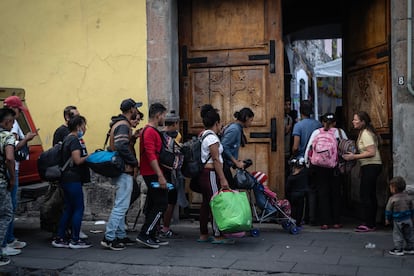

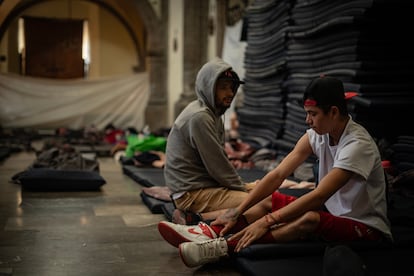
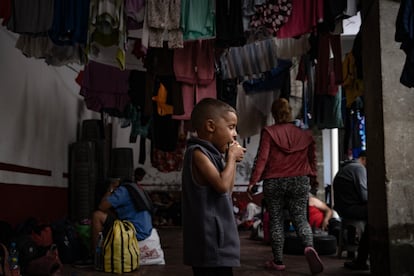
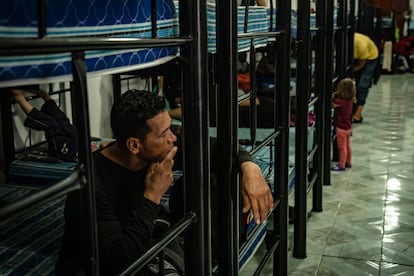
Last night, Father Benito could only sleep for a couple of hours. The rain forced him and the volunteers to relocate a group of migrants who were sleeping in the parish parking lot. He then had to take a Venezuelan woman and her young daughter to the hospital — the child had trouble breathing. And, finally, he had to separate two men who had gotten into a fight, because one had supposedly stolen a watch from the other. Extreme fatigue is evident in his eyes, but, at the same time, an excess of will is evident in his speech: “Given the situation of these people, we cannot turn around and act as if nothing’s wrong. They are men and women — [we must] seek to ensure that their dignity is no longer trampled on. They are looking for a new dawn… and we are going to give them any help that is in our hands,” the priest affirms.
The Church of La Soledad was built at the beginning of the 17th century by brothers of the Order of Saint Augustine. It’s the seventh-oldest in the Mexican capital. Father Benito explains that it was built with the idea of always being at the service of those most in need. “This temple was aimed at people who arrived from [the cities of] Texcoco or Xochimilco, with the intention of selling merchandise in La Merced. While the cathedral was designed for the Spanish, La Soledad received the Indigenous people who came in search of spiritual help,” the parish priest explains. “Nowadays, those who come looking for help are migrants. La Soledad will always have its doors open for them.”
Part of the work of Father Benito and the volunteers consists of visiting markets and food banks in search of donations. Only in this way has the improvised shelter managed to survive: the church’s income has been reduced to a minimum, since it’s currently not able to officiate ceremonies — such as weddings and baptisms — given the space constraints.
Every day, the municipal government of Mexico City sends prepared food to the parish. However, these meals don’t always arrive on time, or they contain ingredients that migrants haven’t been able to get used to, such as heavy spices. Despite the bits of support, the parish priest feels that the actions of the authorities have been lacking when it comes to addressing a crisis that’s getting worse every day: “When you do some good work, everyone applauds you… but when there start to be problems, you’re guilty. The government lets institutions like the [Catholic] Church deal with crises that they can no longer control. For the government, the easiest thing is to wash its hands [of the matter] and let others do what they cannot. We saw this with the fire that occurred in March at the Ciudad Juárez migrant detention center. Dozens of people died due to the inaction of the authorities,” the priest laments.
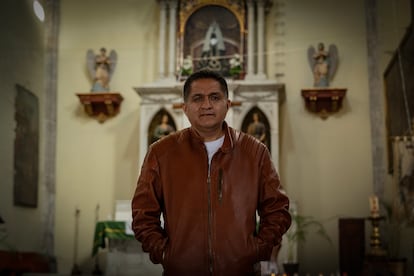
Most migrant shelters in Mexico City are overcrowded. Large spaces such as Casa Tochán or Cafemin — in the Álvaro Obregón and Gustavo Madero municipalities, respectively — now exceed their maximum capacity by up to seven times. The same overcrowding has occurred with the improvised shelter in La Soledad, which — according to Father Benito — was initially designed for a maximum of 80 people. The main nave of the church is already packed: there’s no room for anyone else in the interior patios. The few rooms that are reserved for the sick have no space left. Father Benito and the volunteers who help him have had to empty some of the church’s warehouses, to be able to settle more migrants there. For now, there’s just enough room to cram everyone in… although the team doesn’t rule out that, in the coming weeks, they will have to empty the remaining spaces to continue hosting people.
Mexico City, a new stopover along the route that migrants take
Claudia Torres is the coordinator of La Soledad’s shelter. Originally from Mexico City, she’s 48-years-old and a single mother. Among an endless list of tasks, she’s in charge of receiving everyone who comes to the parish in search of refuge. To each person who enters, Torres informs them that they will only be able to spend two to three days in the shelter. Ideally, by then, the migrants manage to get some work or other accommodations. Meanwhile, a few of them choose to continue advancing towards the border with the United States.
This is how the shelter coordinator explains it: “It’s very dangerous for them to go north. They prefer to stay in Mexico City, where they can earn income more easily and where families feel safer.” For migrants, it’s more convenient to wait in Mexico City for the U.S. authorities to assign them an appointment through the CBP One cellphone application, rather than to simply show up at the border and risk being deported back to their countries of origin.
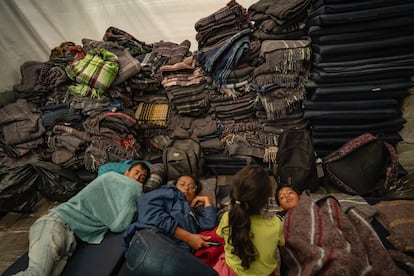
Some of the migrants have managed to extend their stay in La Soledad by volunteering. These people prepare food or help with cleaning tasks. This is the case of Jason Oliveros, a 26-year-old young man from the Venezuelan city of Maracaibo. Oliveros and his family have been staying at the shelter for 21 days. He supports Father Benito’s team by arranging the mats and distributing them to people, so that everyone can have a place to sleep.
For Oliveros, it was 10 times easier to cross the Darien jungle between Venezuela and Panama than to cross through Mexico. This is how the Venezuelan explains it: “No one helps you here. If a ticket to a city costs 25 Mexican pesos [$1.50], when they see that you’re a migrant, they charge you up to 150 pesos ($8.50). People take advantage of us. And the authorities don’t protect us, they take us off the buses and return us to Tapachula. If they return you, you lose a lot of time and money.”
Oliveros came to La Soledad on the recommendation of his brother, who stopped by the church eight months ago. At first, he thought that the shelter was funded by the government. However, after speaking with Father Benito, he realized that all the help is voluntary. His goal is to stay in Mexico City, get a formal job and rent some housing, at least until he gets an appointment through CBP One. “I don’t care if it takes a month, four months or a year. I don’t want to leave this city until I have an appointment. I’m very afraid that they’ll [deport me] on the way. I don’t want to have swam so much to die on the shore,” the young Venezuelan concludes.
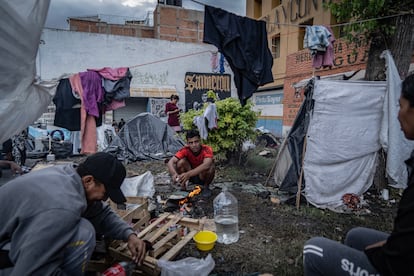

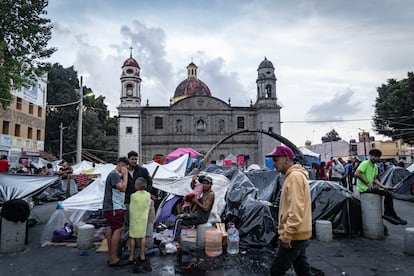

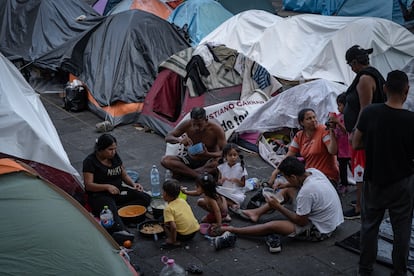
In the surroundings of the church — in a space known as Plaza de la Soledad — a camp has been set up. It consists of more than 150 tents. They are home to migrants who, for the most part, have already stayed in the church and haven’t managed to find a place in another shelter, nor have they been able to save enough money to rent accommodation. Father Benito estimates that there are about 400 people in the square, all waiting for an appointment with the U.S. authorities.
The camp resembles a small town, with businesses such as food stalls, makeshift showers and barbershops. However, the possibility that the authorities will evict everyone is a constant fear among its inhabitants. Officials from the district mayor’s office showed up at this space on October 27. Dressed in cherry-colored vests, they talked with the migrants and collected their information. A rumor quickly began to spread: the camp would be torn down the next day.
Fortunately for the inhabitants of this space, that didn’t happen. However, in the face of recent evictions around Mexico City, migrants refuse to let their guard down. Many shelters are full and job opportunities are scarce. Given the limited space, the inhabitants of the square have nothing left to do but constantly check their cellphones, hoping that a notification will soon arrive from the CBP One application.
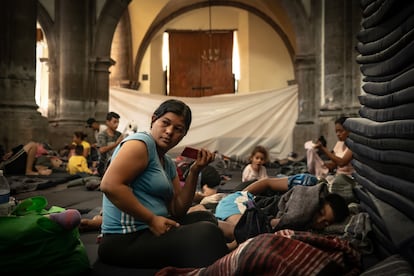
Sign up for our weekly newsletter to get more English-language news coverage from EL PAÍS USA Edition
Tu suscripción se está usando en otro dispositivo
¿Quieres añadir otro usuario a tu suscripción?
Si continúas leyendo en este dispositivo, no se podrá leer en el otro.
FlechaTu suscripción se está usando en otro dispositivo y solo puedes acceder a EL PAÍS desde un dispositivo a la vez.
Si quieres compartir tu cuenta, cambia tu suscripción a la modalidad Premium, así podrás añadir otro usuario. Cada uno accederá con su propia cuenta de email, lo que os permitirá personalizar vuestra experiencia en EL PAÍS.
¿Tienes una suscripción de empresa? Accede aquí para contratar más cuentas.
En el caso de no saber quién está usando tu cuenta, te recomendamos cambiar tu contraseña aquí.
Si decides continuar compartiendo tu cuenta, este mensaje se mostrará en tu dispositivo y en el de la otra persona que está usando tu cuenta de forma indefinida, afectando a tu experiencia de lectura. Puedes consultar aquí los términos y condiciones de la suscripción digital.
More information
Archived In
Últimas noticias
There is as much life left to discover on planet Earth as that which is already known
Dozens presumed dead, around 100 injured in fire at Swiss Alps bar during New Year’s celebration
Is porn for women different from conventional porn? We spoke to those who make it
Cartagena de Indias is sinking: What can the city do to mitigate it?
Most viewed
- Reinhard Genzel, Nobel laureate in physics: ‘One-minute videos will never give you the truth’
- David King, chemist: ‘There are scientists studying how to cool the planet; nobody should stop these experiments from happening’
- Oona Chaplin: ‘I told James Cameron that I was living in a treehouse and starting a permaculture project with a friend’
- Sinaloa Cartel war is taking its toll on Los Chapitos
- The Interoceanic Train, the Mexican alternative to the Panama Canal
